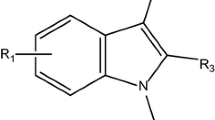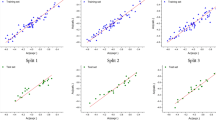Abstract
Hepatitis C virus (HCV) is composed of structural and non-structural proteins involved in viral transcription and propagation. In particular, NS5B is an RNA-dependent RNA polymerase for viral transcription and genome replication and is a target for designing anti-viral agents. In this study, classification and quantitative structure-activity relationship (QSAR) models of HCV NS5B inhibitors were constructed using the Correlation and Logic software. Molecular descriptors for a set of 970 HCV NS5B inhibitors were encoded using the simplified molecular input line entry system notation, and predictive models were built via the Monte Carlo method. The QSAR models provided acceptable correlation coefficients of \(R^{2}\) and \(Q^{2}\) in the ranges of 0.6038–0.7344 and 0.6171–0.7294, respectively, while the classification models displayed sensitivity, specificity, and accuracy in ranges of 88.24–98.84, 83.87–93.94, and 86.50–94.41 %, respectively. Furthermore, molecular fragments as substructures involved in increased and decreased inhibitory activities were explored. The results provide information on QSAR and classification models for high-throughput screening and mechanistic insights into the inhibitory activity of HCV NS5B polymerase.



Similar content being viewed by others
References
El-Serag HB (2004) Hepatocellular carcinoma: recent trends in the United States. Gastroenterology 127:S27–S34. doi:10.1053/j.gastro.2004.09.013
Cooke GS, Lemoine M, Thursz M, Gore C, Swan T, Kamarulzaman A, DuCros P, Ford N (2013) Viral hepatitis and the Global Burden of disease: a need to regroup. J Viral Hepat 20:600–601. doi:10.1111/jvh.12123
Chinnaswamy S, Cai H, Kao C (2010) An update on small molecule inhibitors of the HCV NS5B polymerase: effects on RNA synthesisin vitro and in cultured cells, and potential resistance in viral quasispecies. Virus Adapt Treat 2:73–89. doi:10.2147/VAAT.S9641
Walker MP, Appleby TC, Zhong W, Lau JY, Hong Z (2003) Hepatitis C virus therapies: current treatments, targets and future perspectives. Antivir Chem Chemother 14:1–21
Liang TJ, Ghany MG (2013) Current and future therapies for hepatitis C virus infection. New Engl J Med 368:1907–1917. doi:10.1056/NEJMra1213651
Prachayasittikul V, Worachartcheewan A, Shoombuatong W, Songtawee N, Simeon S, Prachayasittikul V, Nantasenamat C (2015) Computer-aided drug design of bioactive natural products. Curr Top Med Chem 15:1780–1800. doi:10.2174/1568026615666150506151101
Nantasenamat C, Isarankura-Na-Ayudhya C, Prachayasittikul V (2010) Advances in computational methods to predict the biological activity of compounds. Expert Opin Drug Discov 5:633–654. doi:10.1517/17460441.2010.492827
Nantasenamat C, Isarankura-Na-Ayudhya C, Naenna T, Prachayasittikul V (2009) A practical overview of quantitative structure-activity relationship. EXCLI J 8:74–88
Toropova AP, Toropov AA (2014) CORAL software: prediction of carcinogenicity of drugs by means of the Monte Carlo method. Eur J Pharm Sci 52:21–25. doi:10.1016/j.ejps.2013.10.005
Toropov AA, Toropova AP, Benfenati E (2009) Additive SMILES-based carcinogenicity models: probabilistic principles in the search for robust predictions. Int J Mol Sci 10:3106–3127. doi:10.3390/ijms10073106
Toropov AA, Toropova AP, Benfenati E, Gini G, Leszczynska D, Leszczynski J (2012) CORAL: classification model for predictions of anti-sarcoma activity. Curr Top Med Chem 12:2741–2744. doi:10.2174/1568026611212240004
Toropov AA, Toropova AP, Benfenati E, Gini G, Leszczynska D, Leszczynski J, De Nucci G (2013) QSAR models for inhibitors of physiological impact of Escherichia coli that leads to diarrhea. Biochem Biophys Res Commun 432:214–225. doi:10.1016/j.bbrc.2013.02.011
Toropova AP, Toropov AA, Benfenati E, Gini G, Leszczynska D, Leszczynski J (2011) CORAL: quantitative structure-activity relationship models for estimating toxicity of organic compounds in rats. J Comput Chem 32:2727–2733. doi:10.1002/jcc.21848
Toropova AP, Toropov AA, Lombardo A, Roncaglioni A, Benfenati E, Gini G (2012) CORAL: QSAR models for acute toxicity in fathead minnow (Pimephales promelas). J Comput Chem 33:1218–1223. doi:10.1002/jcc.22953
Worachartcheewan A, Mandi P, Prachayasittikul V, Toropova AP, Toropov AA, Nantasenamat C (2014) Large-scale QSAR study of aromatase inhibitors using SMILES-based descriptors. Chemom Intell Lab Syst 138:120–126. doi:10.1016/j.chemolab.2014.07.017
Worachartcheewan A, Nantasenamat C, Isarankura-Na-Ayudhya C, Prachayasittikul V (2014) QSAR study of H1N1 neuraminidase inhibitors from influenza A virus. Lett Drug Des Discov 11:420–427. doi:10.2174/15701808113106660085
Toropov A, Nesmerak K, Raska I Jr, Waisser K, Palat K (2006) QSPR modeling of the half-wave potentials of benzoxazines by optimal descriptors calculated with the SMILES. Comput Biol Chem 30:434–437. doi:10.1016/j.compbiolchem.2006.09.003
Toropov AA, Nesmerak K (2012) SMILES-based QSPR model for half-wave potentials of 1-phenyl-5-benzyl-sulfanyltetrazoles using CORAL. Chem Phys Lett 539–540:204–208. doi:10.1016/j.cplett.2012.04.061
Toropov AA, Toropova AP, Benfenati E, Gini G, Leszczynska D, Leszczynski J (2013) CORAL: QSPR model of water solubility based on local and global SMILES attributes. Chemosphere 90:877–880. doi:10.1016/j.chemosphere.2012.07.035
Batra A, Nandi S, Bagchi M (2015) QSAR and pharmacophore modeling of indole-based C-3 pyridone compounds as HCV NS5B polymerase inhibitors utilizing computed molecular descriptors. Med Chem Res 24:2432–2440. doi:10.1007/s00044-014-1304-6
Pourbasheer E, Riahi S, Ganjali M, Norouzi P (2011) QSAR study of C allosteric binding site of HCV NS5B polymerase inhibitors by support vector machine. Mol Divers 15:645–653. doi:10.1007/s11030-010-9283-0
Srivastava AK, Pandey A, Srivastava A, Shukla N (2011) QSAR based modeling of hepatitis C virus NS5B inhibitors. J Saudi Chem Soc 15:25–28. doi:10.1016/j.jscs.2010.09.007
Wang M, Zhong M, Yan A, Li L, Yu C (2014) Quantitative structure and bioactivity relationship study on HCV NS5B polymerase inhibitors. SAR QSAR Environ Res 25:1–15. doi:10.1080/1062936X.2013.820790
Wang M, Wang K, Yan A, Yu C (2012) Classification of HCV NS5B polymerase inhibitors using support vector machine. Int J Mol Sci 13:4033–4047. doi:10.3390/ijms13044033
Wei L, Ying X (2011) Prediction of hepatitis C virus non-structural proteins 5B polymerase inhibitors using machine learning methods. Acta Phys Chim Sin 27:1407–1416. doi:10.3866/PKU.WHXB20110608
Worachartcheewan A, Prachayasittikul V, Anuwongcharoen N, Shoombuatong W, Prachayasittikul V, Nantasenamat C (2015) On the origins of hepatitis C virus NS5B polymerase inhibitory activity using machine learning approaches. Curr Top Med Chem 15:1814–1826. doi:10.2174/1568026615666150506151303
Liu T, Lin Y, Wen X, Jorissen RN, Gilson MK (2007) BindingDB: a web-accessible database of experimentally determined protein-ligand binding affinities. Nucleic Acids Res 35:D198–D201. doi:10.1093/nar/gkl999
Lapins M, Worachartcheewan A, Spjuth O, Georgiev V, Prachayasittikul V, Nantasenamat C, Wikberg JE (2013) A unified proteochemometric model for prediction of inhibition of cytochrome P450 isoforms. PLoS One 8:e66566. doi:10.1371/journal.pone.0066566
Nantasenamat C, Li H, Mandi P, Worachartcheewan A, Monnor T, Isarankura-Na-Ayudhya C, Prachayasittikul V (2013) Exploring the chemical space of aromatase inhibitors. Mol Divers 17:661–677. doi:10.1007/s11030-013-9462-x
Talete srl (2007) DRAGON for Windows (Software for Molecular Descriptor Calculations), Version 5.5, Milano, Italy
Toropov AA, Toropova AP, Rasulev BF, Benfenati E, Gini G, Leszczynska D, Leszczynski J (2012) CORAL: binary classifications (active/inactive) for liver-related adverse effects of drugs. Curr Drug Saf 7:257–261. doi:10.2174/1574886311207040257
Worachartcheewan A, Nantasenamat C, Isarankura-Na-Ayudhya C, Pidetcha P, Prachayasittikul V (2010) Identification of metabolic syndrome using decision tree analysis. Diabetes Res Clin Pract 90:e15–e18. doi:10.1016/j.diabres.2010.06.009
Ojha PK, Roy K (2011) Comparative QSARs for antimalarial endochins: importance of descriptor-thinning and noise reduction prior to feature selection. Chemom Intell Lab Syst 109:146–161. doi:10.1016/j.chemolab.2014.07.017
Toropova AP, Toropov A, Veselinovic JB, Veselinovic AM (2015) QSAR as a random event: a case of NOAEL. Environ Sci Pollut Res 22:8264–8271. doi:10.1007/s11356-014-3977-2
Acknowledgments
This research project is supported by the annual budget grant (B.E. 2557-2559) and Talent Management Program (AW) from Mahidol University. Partial support is also acknowledged from the Office of the Higher Education Commission and Mahidol University under the National Research Universities Initiative. APT and AAT are grateful for financial support of the EU project PROSIL funded under the LIFE program (project LIFE12ENV/IT/000154).
Author information
Authors and Affiliations
Corresponding author
Ethics declarations
Conflicts of interest
The authors declare that there are no known conflicts of interest.
Electronic supplementary material
Below is the link to the electronic supplementary material.
Rights and permissions
About this article
Cite this article
Worachartcheewan, A., Prachayasittikul, V., Toropova, A.P. et al. Large-scale structure-activity relationship study of hepatitis C virus NS5B polymerase inhibition using SMILES-based descriptors. Mol Divers 19, 955–964 (2015). https://doi.org/10.1007/s11030-015-9614-2
Published:
Issue Date:
DOI: https://doi.org/10.1007/s11030-015-9614-2




